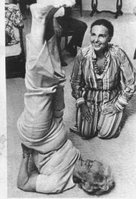Question: Dear Yogi Marlon, I was wondering if you could advise me on a particular pose I am using to help with a neurological condition I have had for over 10 years called Spasmodic Torticollis. The pose is the Corpse pose and I use a folded blanket and a bolster to provide me with the relaxation I need in my upper torso, head and upper back. What I need to know is whether I could use this pose as my normal everyday sleeping position when I go to bed? Would many hours in this position cause any damage to me or produce any adverse effects? I hope you can help me and I appreciate greatly any time you take out of your busy schedule to reply to this email.
Many thanks and kindest regards
Robert
Hello Robert,
You have not indicated where or how you are using a blanket or bolster. True chavasana, or corpse pose, does not us props. It seems likely that you have been instructed to do a restoration pose with the bolster under your knees and the blanket rolled up and placed along the spine about the sacrum, so the pelvis is propped into a tilted position. That is a commonly taught yoga pose. If this is indeed correct, you are doing one of the few things that will stimulate the parasympathetic nervous system to become active. (Ujjayi pranayama is one other technique to do this.
I was not aware of the condition spasmodic torticollis until I googled it just now, finding this definition:
Cervical Dystonia, also known as spasmodic torticollis, is a focal dystonia characterized by neck muscles contracting involuntarily, causing abnormal movements and posture of the head and neck.
This term is used generally to describe spasms in any direction: forward (anterocollis), backwards (retrocollis), and sideways (torticollis). The movements may be sustained or jerky. Spasms in the muscles or pinching nerves in the neck can result in considerable pain and discomfort.
I'm sorry to say I do not know enough about the condition to advise you medically. The best I can do is to urge you to find someone who specializes in yoga therapy, so they can advise you. If you want a name and number of one yoga therapist I know, I am happy to recommend him.
All the best to you and many thanks for your inquiry.
Om shanti,
Yogi Marlon
Thursday, November 30, 2006
Sunday, November 19, 2006
Muladhara Chakra
Hello Yogi Marlon!
It's said that the root chakra contains four leaves, or petals. What do they stand for, and is there a place where i can read or learn about all the leaves/petals???
Alex
Hi Alex,
The root chakra is called the muladhara chakra, which is depicted as having 4 lotus blossum petals. Overall this chakra represents divine energy materializing, and specifically becoming the matter of the physical body.
Psychological tendencies or vrittis are attributed to several chakras, both in their positive and negative forms. The emotions of
greatest joy, natural pleasure, delight in controlling passion, and blissfulness in concentration are attributed to the muladhara chakra.
there is more information about the root chakra at:
http://en.wikipedia.org/wiki/Muladhara
Here is a related article on the practic of mula bandha, which is a practice centered around the muladhara chakra:
http://askyogimarlon.com/archive/a_mula_banda.html
Monday, November 13, 2006
Yoga for the Nervous System

Question: Hello Marlon Is yoga good for anxiety and nervousness? Thankyou.
Name: Davina
Country: England
Hi Davina,
Yoga works quite profoundly on an energetic level, so it is, in fact, one of the best therapies for the nervous system.
In one addition of my column entitled Yoga for the Scattered Mind, I explain the ayurvedic concept of vata dosha. There is an overview that will explain what may be a new way of veiwing the kind of energy that embibes your nervous system. I think you will find it is full of valuable information for maintaining or restoring a healthy nervous system, because the nervous system is very, very akin to vata energy. Please access the full article here:
http://askyogimarlon.com/archive/a_YogaForTheScatteredMind.html
In addition, the best pose to strengthen the nervous system is shoulder stand. Second best is plough. My beginner DVD, Yoga for Absolute Beginners, includes both these poses. You'll find that here:
http://askyogimarlon.com/dvd-beginner.html
Please do comment here, to let all my blog viewers and I know if you have found the articl and the practice of the suggestions have created a significant change for you.
I also invite readers to converse with Davina and I here on your individual experiences.
Many thanks for writing, Davina.
Om Shanti,
Yogi Marlon
Subscribe to:
Posts (Atom)
